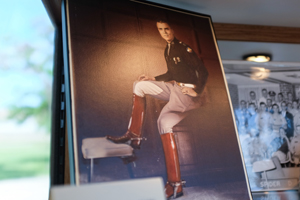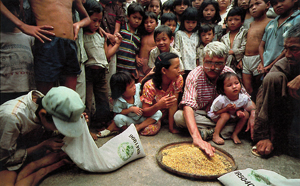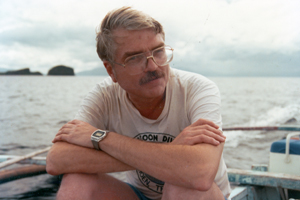The clock reads 7:30 a.m. on Sept. 23, 1994. Dr. Thomas Hargrove ’66 is running late for work at the International Center for Tropical Agriculture (CIAT) in Cali, Colombia. He approaches an intersection, where he must decide which of two routes to take. One involves a nerve-wracking drive through the heavy traffic of urban Cali; the other is longer, but winds through the scenic sugar cane fields of the Colombian countryside. He remembers one of the rules for a better life that American author Robert Fulghum used: “Always take the scenic route.” It was the last decision he would make for a long time.
Everything Before Then
 While at Texas A&M, Hargrove was a class officer and a member of Company D-1 in the Corps of Cadets.
While at Texas A&M, Hargrove was a class officer and a member of Company D-1 in the Corps of Cadets.
Hargrove grew up on a red-dirt, dry-land cotton farm in Rotan, Texas. He began attending Texas A&M University in 1962 and graduated in 1966 with degrees in agricultural science and journalism along with a commission as a second lieutenant in the United States Army. While at Texas A&M, he was a class officer, a member of Company D-1 (Spider D) in the Corps of Cadets and editor of The Agriculturalist, a magazine published by the College of Agriculture.
A deferment allowed Hargrove to earn a master’s degree and Ph.D. in agricultural science from Iowa State University and to marry the daughter of a pioneer Rotan family, Susan Sheldon, before going to Vietnam in 1969 as an agricultural advisor to Advisory Team 73, Military Assistance Command in Chuong Thien province. Located at the southern tip of Vietnam’s Mekong Delta, it was one of the country’s most war-torn areas.
Traveling mostly by sampan on canals and rivers, Hargrove was charged with introducing IR8, a newly developed, high-yield rice variety, to farmers in the region. Nicknamed “the miracle rice” by international media, the strain revolutionized rice production and contributed to the Green Revolution. (IR8 was developed by Henry Beachell, who helped form the Texas Rice Improvement Association to sustain rice research at Texas A&M and whose endowed professorship and scholarships support the Department of Soil and Crop Sciences.) It also sparked Hargrove’s fascination with rice and its role in the fight against starvation around the world.
 Hargrove was charged with introducing IR8, a newly developed,high-yield rice variety, to farmers in Vietnam.
Hargrove was charged with introducing IR8, a newly developed,high-yield rice variety, to farmers in Vietnam.
Years later, on a return trip to Vietnam, Hargrove met a former Viet Cong officer who remembered him from the war years. The officer told Hargrove he could have killed him at any time during the war. When Hargrove asked why he hadn’t, the officer replied, “Because you had the rice seeds.”
Three years after an honorable discharge from the army, Hargrove became a journalist in 1973 with the International Rice Research Institute (IRRI) in Manila, Philippines. Friends jokingly called him a “rice bore,” but his work translating complex crop science into plain language helped farmers in developing countries increase their yields. One of his publications through IRRI, A Farmer’s Primer on Growing Rice, was written and distributed in 44 countries in 29 different languages.
Hargrove relocated to CIAT in 1992 as head of its communication program, in charge of publicizing how CIAT improved varieties and technology for beans, cassava and tropical pastures in Latin America and the Caribbean.
Two years into his work with the center, he confronted the day that would alter his life for the next 11 months.
Life in Limbo
Having decided on the scenic route, Hargrove’s picturesque drive to work ended when he approached a roadblock manned by Colombian Narco-guerrillas of the Armed Revolutionary Forces of Colombia (FARC), a U.S.-classified terrorist organization. In a matter of minutes, his briefcase and $400 were confiscated and he was taken hostage—presumably because he was a foreigner.
His captors took him to a remote location in the Andes Mountains, where he lived as a prisoner during the next 11 months in harsh conditions, spending most of his time in a plastic-covered shed or—for a two-month period—tethered day and night to his bunk bed with a 15-foot chain.
“During those 11 months, we had no contact with Tom whatsoever, except for a proof-of-life video and one photograph. In the video, he was speaking Spanish, asking for help, for his life. In the photograph, he looked so sick I thought he had lost his mind, and wondered what we would find if he ever was released,” said Raford Hargrove ’70, Tom’s brother.
Colombia is notorious for kidnapping incidents, and FARC is a leading culprit. Most abductees are held until a ransom is negotiated, a task that Tom’s wife Susan and his sons, Miles and Geddie, had to master.
“Susan and the boys were in sporadic contact with the FARC, using two-way radios and a Spanish-speaking interpreter. They would hang on to every word, and then the FARC messenger would abruptly cut off communication for another period of days or weeks,” Raford said.
Negotiations were slow-going and stressful, but culminated in the payment of two ransom demands and ultimately Hargrove’s release on Aug. 11, 1995.
“I met him in Houston a couple days later. We embraced, and I remember feeling a bag of bones in my arms. He pulled off a money belt and showed me where he had hidden two things: a small collection of antibiotic pills he had secreted, in case he got a severe infection, and little scraps of paper, documenting his captivity,” Raford said.
When the captors took Hargrove’s briefcase and money, they returned to him two checkbooks. On the backs of First National Bank of Rotan check blanks, he kept a diary that was published in 1997 as a book, "Long March to Freedom: Tom Hargrove’s Own Story of His Kidnapping by Colombian Narco-Guerrillas." His captivity also inspired the 2000 movie, “Proof of Life,” which starred Meg Ryan and Russell Crowe.
Return to Reality
Upon his release and return to the U.S., Tom worked as a kidnapping and antiterrorism consultant, conducting training courses at the U.S. Joint Special Operations University and United States Air Force Special Operations School, where he was adjunct professor of dynamics of international terrorism.
 Upon his release and return to the U.S., Tom worked as a kidnapping and anti-terrorism consultant.
Upon his release and return to the U.S., Tom worked as a kidnapping and anti-terrorism consultant.
He later became involved with the Houston Livestock Show and Rodeo™, serving nearly a decade as a pressroom editor, where he oversaw and mentored Texas A&M agricultural student interns. His last full-time job was as an employee of the International Fertilizer Development Center in Muscle Shoals, Alabama.
Hargrove died of heart failure on Jan. 23, 2011, at age 66. He was buried on the family’s farm, where Aggies from all over came to sing “The Spirit of Aggieland” one last time at his grave. His life is captured by a simple list on his tombstone that reads: “Farmer, Aggie, Soldier, Scientist, Writer, Survivor, and Master of the Green Revolution.”
An Innovator and Inspiration
“When he passed away, the first thing I thought was, ‘I do not want Tom’s tracks to be forgotten,’” said Rev. Jim Lanning ’64, a lifelong friend. “Tom was a friend to the world, and I cannot think of a better way to leave one’s legacy than to address the issue of hunger. He greatly inspired me by showing no fear in the face of danger and by seeking out adventure. His desire to serve his fellow man was mixed with his desire to explore new places.”
Lanning helped spearhead the effort to establish through the Texas A&M Foundation the Dr. Thomas R. Hargrove ’66 Endowed Memorial Scholarship, funded by friends and family of Hargrove. The scholarship is designated for students majoring in agricultural communications and journalism within the Department of Agricultural Leader ship, Education and Communications at Texas A&M, in keeping with Hargrove’s passions and life mission. It gives preference to students with an interest in international agriculture, public relations for an agricultural entity, or those pursuing advanced degrees in an agricultural discipline.
“When we learned about the plans for this scholarship, we knew we wanted to be a part of it,” said Leroy Shafer ’67. “Tom dedicated his life to agriculture, communications and helping feed people all over the world. He accomplished his mission through research, communication, and implementation by example, and by genuinely caring for the people he assisted.”
Shafer and his wife Nancy are the lead donors for the scholarship. Shafer is vice president and chief operations officer for the Houston Livestock Show and Rodeo™, but he knew Hargrove as more than a professional colleague; the two have a dated history. Growing up in West Texas, their family farms were about 20 miles apart; both majored in agricultural journalism and were members of Company D-1 at Texas A&M; and both served in Vietnam.
“This scholarship will benefit future students in the field of agricultural communications while keeping alive the legacy of a tremendous man, humanitarian, educator and communicator,” Shafer said. “If future students who receive Tom Hargrove scholarships carry on the mission that he started, then Tom’s legacy will live on and the world will be a far greater place.”
The first recipient of the scholarship, awarded April 11, is Rachel Wales ’15, an agricultural communications and journalism major involved in St. Mary’s Catholic Church Women’s Chorus, Relay for Life and Big Event.
“The support of former students through this scholarship demonstrates to me the vitality of the Aggie family and proves that Aggies want to help each other succeed,” said Wales, who also holds an on-campus job at The Association of Former Students and is self-funding her degree.
“We hope that Aggies will be inspired to know that it is just as important, if not more important, to spread the word of agricultural research accomplishments as it is to make those accomplishments yourself—because if no one knows about them, they don’t do anyone any good. Tom understood that,” Raford said.
This article was originally published in the summer 2014 issue of Spirit magazine.
Texas A&M Foundation
The Texas A&M Foundation is a nonprofit organization that solicits and manages investments in academics and leadership programs to enhance Texas A&M’s capability to be among the best universities.
You can support the College of Agriculture and Life Sciences with a gift of an endowment to the Texas A&M Foundation. For additional information about how to benefit the College, contact Mark Klemm ’81 with the Foundation at (800) 392-3310, (979) 845-6537or mklemm@txamfoundation.com.